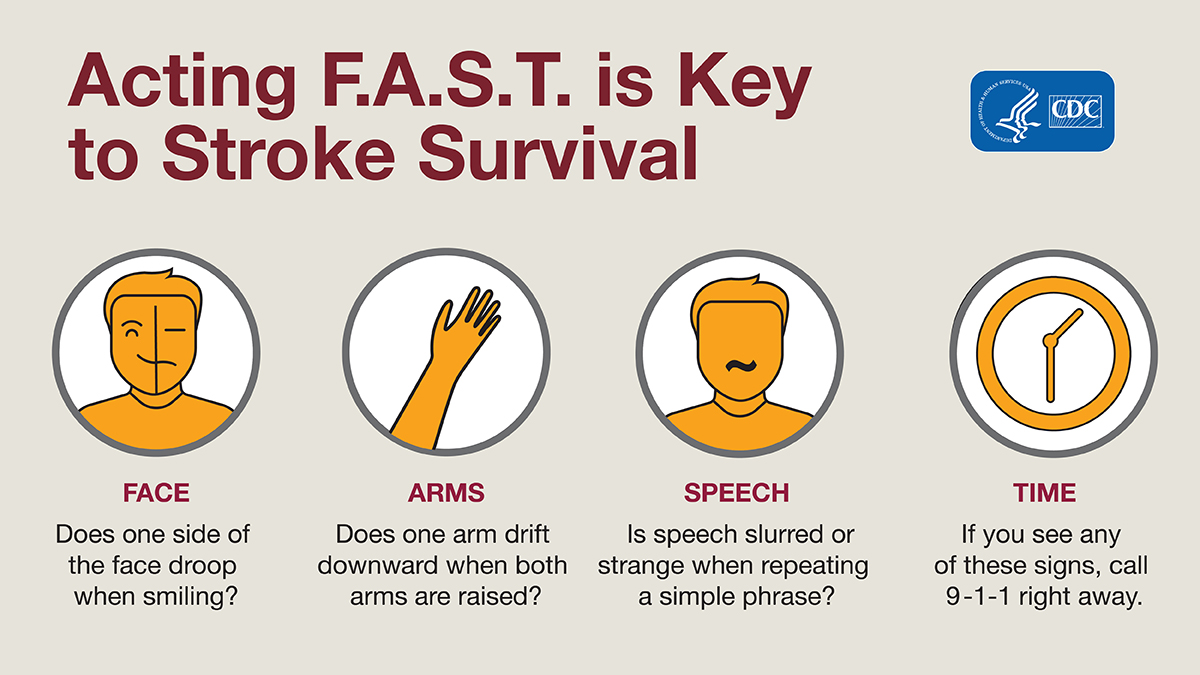Key points
- Stroke is a leading cause of death among men.
- About 4 in 5 strokes are preventable.

Overview
Stroke is a leading cause of death among men.1 Stroke is also a leading cause of long-term disability,2and men under age 44 are hospitalized for certain types of stroke at a higher rate than women in the same age group.3
These facts are alarming, but there is good news: about 4 in 5 strokes are preventable.4 That's why it's important to know your risk for stroke and take action to protect your health. And you can learn more about how CDC and its partners are leading programs to help men reduce their risk of stroke.
What is a stroke?
A stroke, sometimes called a brain attack, happens when blood flow to an area of the brain is blocked or when a blood vessel in the brain bursts. When brain cells are starved of oxygen, they die.
Stroke is a medical emergency. It's important to act F.A.S.T and get treatment as soon as possible (see sidebar). Call 9-1-1 right away if you or someone you are with shows any signs of having a stroke.
Some treatments for stroke work only if given within the first 3 hours after symptoms start. A delay in treatment increases the risk of permanent brain damage or death.

Risk factors
High blood pressure, also called hypertension, is a major risk factor for stroke.
Half of men (50.6%) have high blood pressure greater than or equal to 130/80 mm Hg or are taking medicine for their blood pressure.5 Four out of 5 men with high blood pressure do not have their blood pressure controlled.5
Other risk factors for stroke include the following:
- Smoking damages blood vessels, which can cause a stroke. About 1 in 7 men smoke.6 Men are also more likely to be smokers than women are.7
- Overweight and obesity. Having overweight or obesity increases stroke risk. About 3 in 4 men in the United States have overweight or obesity.8
- Diabetes increases stroke risk because it can harm blood vessels in the brain. About 1 in 7 men have diabetes.9
- Too much alcohol. Drinking too much alcohol can raise blood pressure levels and increase the risk for stroke. It also increases levels of triglycerides. These are a form of fat in your blood that can harden your arteries. Men are more likely than women to drink too much alcohol.10
- Not enough physical activity. Not getting enough physical activity can lead to other health conditions that can raise the risk for stroke. In 2017, about half of men met the guidelines for aerobics and muscle strengthening.6
At-risk populations
Why are African American men at higher risk for stroke?
- More than 1 in 2 African American men have a blood pressure greater than or equal to 130/80 mm Hg or are taking medicine to control their blood pressure.11
- About 1 in 9 African American men have been diagnosed with diabetes, and many more have the disease but do not know it.9
- Sickle cell disease, a common genetic disorder in African Americans, can lead to a stroke. About 1 in 365 African American babies are born with sickle cell disease.12
- About 1 in 5 African American men smoke.13
- About 7 in 10 African American men have overweight or obesity.8
- US adults, including African Americans, consume more than the recommended amounts of salt or sodium. This raises blood pressure and increases the risk for stroke.
Why are Hispanic men at risk for stroke?
- About half of Hispanic men have a blood pressure greater than or equal to 130/80 mm Hg or are taking medicine to lower blood pressure—a major risk factor for stroke.11
- About 1 in 7 Hispanic men have been diagnosed with diabetes. Many more have the disease but do not know it. Diabetes is also more common in people of Mexican and Puerto Rican ancestry than in people of Cuban or Central/South American ancestry.9
- About 1 in 7 Hispanic men smoke.14
- More than 4 in 5 Hispanic men have overweight or obesity.8
Prevention
Most strokes can be prevented by keeping medical conditions under control and making healthy lifestyle changes.
Know your ABCS of heart and brain health
- Aspirin: Aspirin may help reduce your risk for stroke by preventing blood clots, but you should check with your doctor before taking aspirin to make sure it is right for you.
- Blood pressure: Control your blood pressure with healthy lifestyle changes (see below). If a blood pressure medicine is prescribed, take it as directed. Learn more about blood pressure.
- Cholesterol: Manage your blood cholesterol with healthy lifestyle changes. If a cholesterol medicine is prescribed, take it as directed. Learn more about cholesterol.
- Smoking: Don't start smoking. If you do smoke, learn how to quit.
Make lifestyle changes
- Eat healthy. Choose healthy foods, including foods with less salt, or sodium, to lower your blood pressure and foods that are rich in fiber and whole grains to manage your cholesterol. Learn more about healthy eating basics from ChooseMyPlate.gov. Learn small steps you can take to boost your healthy eating habits from the "Live to the Beat" campaign.
- Get regular physical activity. Regular physical activity helps you reach and maintain a healthy weight and keeps your heart and blood vessels healthier. Adults age 18 and older should get at least 150 minutes (2 hours and 30 minutes) of physical activity each week and do muscle strengthening activities on 2 or more days each week.13 Find inspiration and tips for getting regular physical activity from the "Live to the Beat" campaign.
Work with your health care team
- Talk to your doctor about your chances of having a stroke, including your age and whether anyone in your family has had a stroke. Learn how to find the right doctor for you from the "Live to the Beat" campaign and how to make small steps toward heart-healthy living from the "Start Small. Live Big." campaign.
- Get other health conditions under control, such as diabetes or heart disease.
What CDC is doing
CDC and its partners are leading national initiatives and programs to reduce rates of death and disability caused by stroke and to help men and women live longer, healthier lives.
- CDC's Division for Heart Disease and Stroke Prevention (DHDSP) provides resources to all 50 states to address heart disease and stroke and helps lead or support the following:
- The WISEWOMAN program provides low-income, underinsured, or uninsured women with chronic disease risk factor screening, lifestyle programs, and referral services. These efforts can help to prevent heart disease and strokes.
- The Paul Coverdell National Acute Stroke Program funds states to reduce death and disabilities from stroke.
- The Million Hearts® initiative, which is co-led by CDC and the Centers for Medicare & Medicaid Services, works with other federal agencies and private-sector partners to raise awareness about heart disease and stroke and prevent attacks and strokes.
Resources
CDC
Million Hearts® and CDC Foundation
"Heart-Healthy Steps." This campaign encourages adults 55 and older to get back on track with the small steps. Scheduling medical appointments, getting active, and eating healthy can all help people get back to living big.
"Live to the Beat." This campaign focuses on empowering Black adults to pursue heart-healthy lifestyles on their own terms. When people find what works best individually and consistently, they can live to their own beat.
Other organizations
- National, Heart, Lung, and Blood Institute: What Is a Stroke?
- National Institute of Neurological Disorders and Stroke (NINDS): Stroke Information Page
- NINDS Know Stroke Campaign
- NINDS Know Stroke Campaign Spanish Toolkit
- National Center for Health Statistics. Multiple cause of death 2018–2022 on CDC WONDER Database. Accessed May 3, 2024.
- GBD 2019 Diseases and Injuries Collaborators. Global burden of 369 diseases and injuries in 204 countries and territories, 1990–2019: a systematic analysis for the Global Burden of Disease Study 2019. Lancet. 396(10258):1204–1222.
- George MG, Tong X, Bowman BA. Prevalence of cardiovascular risk factors and strokes in younger adults. JAMA Neurol. 2017;74(6):695–703.
- Lackland DT, Roccella EJ, Deutsch AF, et al. Factors influencing the decline in stroke mortality: a statement from the American Heart Association/American Stroke Association. Stroke. 2014;45(1):315–353.
- Centers for Disease Control and Prevention. Hypertension cascase: hypertension prevalence, treatment and control estimates amoung US adults aged 18 years and older applying the criteria from the American College of Cardiology and American Heart Association's 2017 Hypertension Guideline—NHANES 2017–2020. Accessed May 3, 2024.
- National Center for Health Statistics. FastStats: Men's health. Accessed May 13, 2022.
- National Center for Health Statistics. Percentage of current cigarette smoking for adults aged 18 and over, United States, 2019–2020. National Health Interview Survey. Accessed May 13, 2022. https://wwwn.cdc.gov/NHISDataQueryTool/SHS_adult/index.html
- National Center for Health Statistics. Table 26. Normal weight, overweight, and obesity among adults aged 20 and over, by selected characteristics: United States, selected years 1988–1994 through 2015–2018 [PDF – 255 KB]. Centers for Disease Control and Prevention; 2018.
- Centers for Disease Control and Prevention. National Diabetes Statistics Report: estimates of diabetes and its burden in the United States. Accessed May 13, 2022.
- Centers for Disease Control and Prevention. Excessive alcohol use and men's health. Accessed May 13, 2022.
- Ostchega Y, Fryar CD, Nwankwo T, Nguyen D. Hypertension prevalence among adults aged 18 and over: United States, 2017–2018. NCHS Data Brief. 2020;(364):1–8.
- National Heart, Lung, and Blood Institute. Sickle cell disease: causes and risk factors. Accessed May 13, 2022.
- National Center for Health Statistics. FastStats: health of Black or African American non-Hispanic population. Accessed May 13, 2022.
- National Center for Health Statistics. FastStats: health of Hispanic or Latino population. Accessed May 13, 2022.
